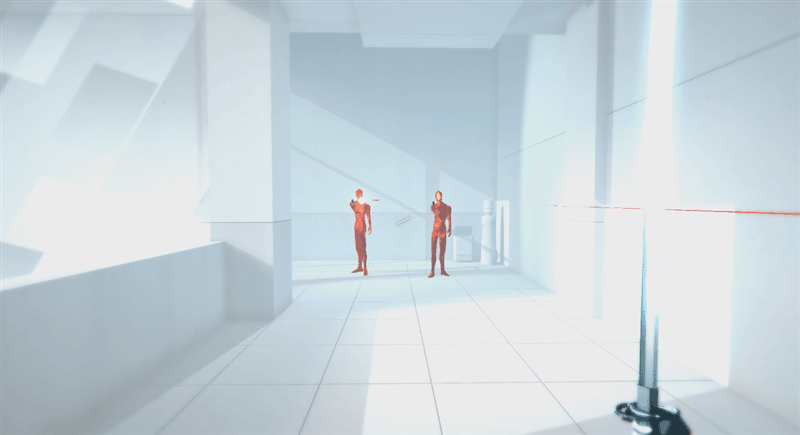
There’s a lot of complaining about the fact that the creators of SUPERHOT, an independent developer that made this first-person shooter-puzzler on a Kickstarter budget, can have the audacity to charge $25 for a game with a two-hour campaign. I find such a complaint hilarious because most of those who ask this question would probably still pay $20 to $30 for an evening to go out and see the new action movie Hardcore Henry: a mediocre movie selling itself on the fact that it is an adrenaline-rushed knock off of Jason Statham’s Crank that shows you the cool stunts you wish you could pull off in any given first-person shooter that you’ve played in the last 20 years. This could be said about nearly any mindless low budget post-Taken action film, honestly.
SUPERHOT, on the other hand, while short, is the new example in game development for “quality over quantity.” Despite its minimalist art direction, it has such a fresh and rich core gameplay mechanic, that has barely even had its surface scratched by its own developers, that I bet it could have an even more blood pumping experience executing this fever dream myriad of action movie stunts with your own mouse and keyboard with an even slightly bigger budget sequel.

Once you load into the gameplay through a fake DOS menu, you occupy the headspace of a nameless, voiceless mannequin character, and enter missions to beat up and obliterate some agitated red mannequins. Except that the catch here is that time, from your perspective, moves at a millionth of a second while standing still, and only slightly faster while you’re in motion through the map. This single aspect of SUPERHOT turns a nearly inescapable situation into a marvelous puzzle game that looks and feels like a briskly paced action shooter when you’ve adjusted to how it all works. In every mission, you’ll be put in a situation where you need to meticulously think about which enemy to kill first, what weapon to kill him with, where his shots will end up, and so on. When you’re neck-deep into these levels, you’ll find yourself knocking pistols out of one enemy’s hands, and throwing it at another enemy before his bullet can leave its chamber. There are hundreds of ways to complete these levels, and it entirely depends on your style of play and your own reflexes, because every second and every slight movement affects your outcome in every level.

Once you reach the final act of SUPERHOT’s main campaign, you eventually have the ability to swap bodies, or “hot switch” with your enemies if you’re in a line of fire and can’t get out. This is a function of the game that allows you to think a little differently, like setting enemies up for friendly fire, but it doesn’t change all that much. While the possibilities seem endless at first with three types of firearms, a katana, and throwable objects throughout the game, it’s very easy to see how limited this armory of weapons is when you reach the final levels and need to meticulously squirm and dodge and kill enemies. When you reach these points, there are functions that you discover through experimentation or word of mouth, like the ability to shoot or slice bullets making their way in your direction or utilizing the time dilation by holding the spacebar on a jump, and these new methods go a long way in your replays of the campaign and the challenge levels, and you will be replaying them.

I completed the main campaign of SUPERHOT in about 3 hours, and the majority of that last hour was my struggle with the campaign’s final few levels. Specifically, the absolute last one, in which every millisecond of your time is meaningful to your survival for the duration of a hidden timer, and while spawning you’re flying back on your feet, have two pistols pointed at you, a shotgun pointed to your back and a corpse with a gun on your left. I tried that one a lot. There’s a fair amount of additional content, but the ones you’ll mostly be participating in are the game’s four endless modes, and the challenge modes of almost all of the campaign’s maps, for example clearing through levels exclusively killing with a katana.
To me, SUPERHOT was slick and stylish enough with three colors, low poly models, and a selection of expertly designed levels and could have done well without a story, and instead more maps to play through. That being said, the story that does present itself isn’t bad, but it’s the kind of meta-narrative that purposefully doesn’t explain all too much until it reaches a point where you’re not invested in it, and you just want to keep playing the game because, for one, it’s telling you that you want to keep playing the game, and two, it genuinely does get your blood pumping when you’ve finished a level. While the ultimate payoff concludes with a pretty good inside joke, the kind of consumer-level acknowledgment here doesn’t match that achieved in games like Undertale, but that is an unfair comparison to a game that is all about narrative. The story for SUPERHOT is merely supplemental, and for being what it is, it works just fine. I simply felt that effort towards a story could have been saved for a more fleshed out narrative in a sequel, but this feeling of being inconvenienced by a quasi-cutscene is only a testament to how much I was enjoying the gameplay of SUPERHOT to the point that I didn’t want it to go away.
[youtube https://www.youtube.com/watch?v=9_WE190zPa4?rel=0]
Advertisement
Rating: 8.5/10
SUPERHOT is available now on PC, Mac and Linux, and will be coming soon on Xbox One
Advertisement






